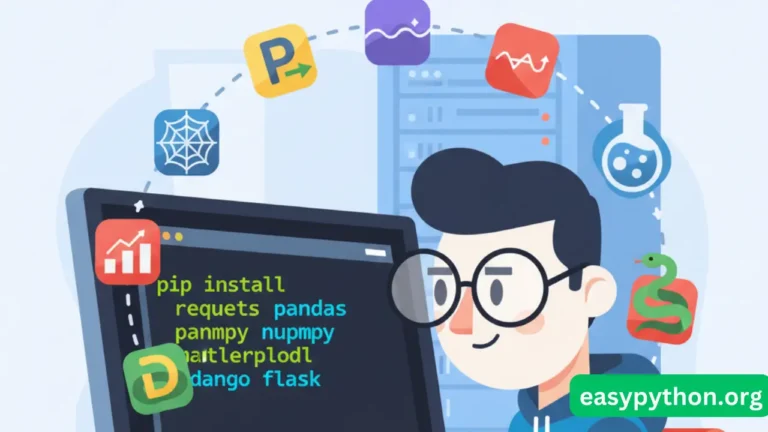So, you just installed Python… you typed your first print("Hello World!")… and suddenly, some tutorial tells you: “Now just install the external module using pip.”
Bruh. You’re like: “pip?? what is this? A new TikTok dance??” 💃🐍
Don’t worry, my friend. Pip isn’t a dance move (though it should be). It’s the magical little tool that turns Python into a super-powered beast by letting you install external packages. Think of it as Python’s Uber Eats — delivering fresh, hot modules right to your project. 🚀
In this guide, I’ll break down how to install Python packages using pip without confusing you with PhD-level explanations. (Spoiler: it’s easier than making Maggi noodles 🍜).
What is pip in Python?
Let’s start at the start.
pip = “Pip Installs Packages”.
(Yes, it’s recursive. Yes, nerds thought that was funny.)
Basically, pip is a package manager. Packages are pre-built chunks of code written by other people so you don’t have to reinvent the wheel.
Want to work with Excel? There’s a package. Want AI stuff? There’s a package. Want to track your ex’s Instagram likes? (Not recommended, but there’s probably a package).
👉 Official docs if you want to get nerdy: Python pip documentation.
How to Check if pip is Installed
First things first: is pip even there?
Open your terminal/command prompt and type:
pip --versionIf you see something like:
pip 23.2.1 from C:\Python\Lib\site-packagesCongrats 🥳 — pip is alive and kicking.
If you get a “pip not recognized” error… don’t panic. It usually means Python wasn’t added to PATH or pip wasn’t installed properly. You can fix that by reinstalling Python with the “Add to PATH” option checked.
👉 Need help starting from zero? Check my guide on getting started with Python.
Installing Your First Package Using pip
Here’s the fun part.
Say you want to install the famous Requests library (used for making HTTP requests). Just run:
pip install requestsBoom 💥 — pip fetches the package from PyPI (Python Package Index) and installs it.
Now in Python:
import requests
print(requests.__version__)And just like that, you’re coding like a pro hacker from a Netflix drama (minus the hoodies and green text rain).
Common pip Commands You’ll Use Daily
Here’s your pip survival kit (bookmark it!):
- Install a package
pip install package_name - Upgrade a package
pip install --upgrade package_name - Uninstall a package
pip uninstall package_name - List installed packages
pip list - Save dependencies
pip freeze > requirements.txt - Install from requirements.txt
pip install -r requirements.txt
👉 Related reading: Python built-in functions and modules list.
Installing Multiple Packages at Once
Because who has time to install them one by one?
pip install numpy pandas matplotlibSuddenly your Python is ready for data science marathons 📊.
👉 Curious about what these packages do? Check Python data types overview and collection types.
pip and Virtual Environments
Imagine installing random apps on your phone without organizing them. Chaos, right? Same with Python.
That’s why we use virtual environments — isolated sandboxes where your project’s packages live without messing up global Python.
python -m venv myenv
myenv\Scripts\activate # Windows
source myenv/bin/activate # Mac/Linux
pip install flaskBoom — your Flask project is now isolated and won’t fight with your Django project. Peace restored ✌️.
Common pip Errors (and Fixes)
Because let’s be honest — something will go wrong.
- pip not recognized → Add Python to PATH or reinstall.
- SSL errors → Upgrade pip:
python -m pip install --upgrade pip - Permission denied → Use
--userflag or run as admin. - Package not found → Double-check the name on PyPI.
👉 Also see: Python indentation errors guide — another classic beginner headache.
FAQs About Installing Packages with pip
Do I need internet for pip?
Yep. Unless you’ve already downloaded the wheel file for offline installs.
pip vs conda — which is better?
pip = Python-only, conda = Python + other stuff (like C libraries). For beginners, pip is simpler.
Can I install multiple versions of the same package?
Yes, but only inside separate virtual environments (otherwise it’s chaos).
Final Words
At first, pip looks scary — like some hacker’s command. But really, it’s just a friendly delivery boy bringing you packages. Once you get comfy with pip, Python becomes limitless.
So the next time you see a tutorial that says “just pip install this”, don’t panic. You’ve got the survival kit now.
👉 Want to level up more? Check my guides on Python variables, user input, or even IDLE tutorial.
Happy coding, and may your pip install never fail! 🎉




